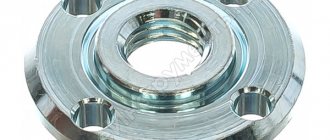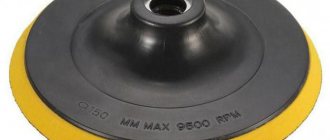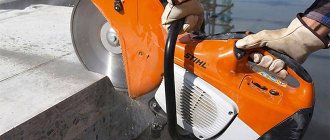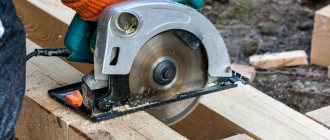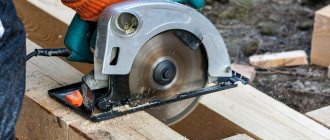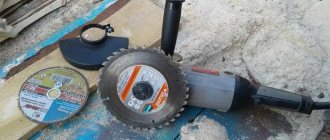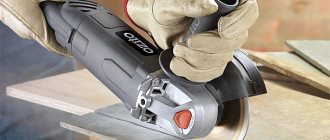Schematic diagram of the grinder
Any craftsman who often works with metal knows the electrical circuit of an angle grinder. A grinder is a tool that is most often used for cutting metal. This tool is a source of increased danger, so you should check the serviceability of the electrical and mechanical components of the structure before each use.
Schematic diagram of the grinder.
An angle grinder, which in the post-Soviet territory is called “grinder”, was the dream of every home craftsman 3-4 decades ago. 30-40 years ago, this working tool was produced by one manufacturer, the Eltos-Bulgarka plant, located on the territory of Bulgaria in the city of Plovdiv. Currently, manufacturers offer consumers various models and modifications of this tool, but the main design components have remained virtually unchanged. Most of the structural elements on different models and modifications differ only in size.
Operations that can be performed with a grinder
The shredder is a multifunctional tool. The driving mechanism in it is an electric motor, which through a gearbox transmits movement to a shaft with a replaceable nozzle installed on it. The general view of the device is shown in the photo below.
There are models on the market that differ in power and design:
Angle grinder (grinder) FT-1318
Professional large grinding machine 230 mm Stern AG230B
Powerful devices are powered by a three-phase voltage of 380 V, and household devices are powered by a single-phase 220 V network. There are also low-power battery models.
Angle grinder (angle grinder) can be made of different materials as follows the main types of work:
- cutting;
- Grinding;
- Polishing.
The angle grinder is designed to work with the following materials:
- Concrete;
- Metal;
- Tree;
- Glass;
- Ceramic tile;
- Stone;
- Brick;
- Plastic.
Grinding machines are widely used both in everyday life and in industrial settings. This is due to their wide functionality due to the following factors:
- A good selection of different attachments made of different materials to perform different operations;
- Possibility of fixed fixation using special fasteners;
- Some models have additional handles and several speed modes.
In this case, keep in mind that only special discs are used to process each material.
Soft start connection
An electronic speed controller is mainly needed by home craftsmen to expand the capabilities of an angle grinder in terms of grinding and processing soft materials.
Professionals, as a rule, use specialized tools for certain types of work and use angle grinders only for their intended purpose. The situation is different with a soft starter. For a household tool with little power, this option is useful, but not necessary. But for professional angle grinders with drives over 1000 W, it is vital. In addition to the performance improvements listed above, a smooth start is critical to operator safety. A grinder with a Ø230 wheel and a power of 2000 W weighs 5÷6 kg, and to hold it during the starting jerk requires some effort and a stable position. The soft start unit can be purchased at retail chains and independently mounted inside the housing of any angle grinder. The video below shows its installation on a new powerful angle grinder purchased by the author for stripping work. This video is also interesting because its author, using a pointer device, demonstrates the magnitude of the current jump when turning on the angle grinder, first without a soft start, and then with this device.
The most advanced control device for an angle grinder is the system for maintaining speed under load, which also functions as a rotation speed regulator and ensures a smooth start. On the Internet you can find a diagram for manufacturing such a device on the U2010B chip, but it is quite complicated even for those who have basic amateur radio skills. Is it possible to purchase a ready-made speed control unit and how much does it cost? If anyone can answer this question, please share the information in the comments.
What are the dangers of an angle grinder?
Angle grinder. Traumatic instrument. This is due to the following reasons:
- High speed of rotation of the working nozzle. It exceeds 10,000 rpm;
- Openness (insecurity of the case) of most of the disk;
- The ability to break the abrasive disc into fragments of different sizes, which in this case fly at considerable speed;
- Frequent inability to properly organize the workplace;
- Formed when cutting metal (or other material) or grinding small particles.
When the disc is stuck, which happens even due to its slight curvature, the sharpener is almost impossible to hold in your hands, especially for a powerful tool. This is due to the high speed of the nozzle. Therefore, beginners are recommended to work with low-power models equipped with disks with a diameter of 115-125 mm. The latter must be free from the slightest defects, which could lead to their sudden destruction and separation of the angle grinders from the hands with uncertain consequences.
Replacing graphite brushes
Failure of graphite brushes is one of the most common breakdowns of an angle grinder.
The service life of this tool design element is about 1.5-2 years. The process of replacing brushes is not particularly difficult. To replace these structural elements, you will need to open the instrument body. After opening the housing, use a screwdriver to lift and slide the brush holders, which are attached to the commutator.
Brushes should be replaced only with branded ones purchased in specialty stores. When purchasing a new brush, it should be compared with the original one, which was removed from the tool. The new brush must completely, in all respects, match the one removed from the grinder. After installing new brushes, you should check their smooth movement.
After installing and checking the smooth movement of the brush, it is fixed using a brush holder. After fixing the brush holder, the tool body closes.
Replacing brushes is the only operation that should be carried out on your own during the repair process; other types of repairs are best left to specialists.
General safety rules
To reduce the risk of injury when operating a sander, this tool must be used correctly. The following rules of use must be observed:
- Must use personal protective equipment. The operator's health must be in good condition.
- Before starting work, it is necessary to check that the casing is fastened correctly and securely so that it does not fall out during the process and sparks do not fly away to the operator.
- Use only complete discs without defects (cracks, chips, cracks) and strictly for the purpose of processing a specific material.
- A protective screen must be located between the operator and the circle so that there is protection if the latter is destroyed.
- Before starting work, it is necessary to check the serviceability of the tool at idle speed for about 1 minute: uniform rotation at maximum speed, no vibration.
- Before use, inspect all attachments to determine their suitability for use.
- It is necessary to protect items that could ignite from asbestos sparks or ordinary damp cloth: greasy cloth, fuel and lubricants, paper, solvents, ropes.
- Always reliable to fix working attachments so they don't fly off.
- If it is possible to control the rotation speed, set the speed recommended for cutting or sanding the workpiece.
- The tree is cut very carefully, since falling on a branch can cause the tool to be torn out of your hands.
- It is forbidden to install nozzles from a circular saw, because they are designed for different spindle speeds.
- Requires holding the tool with both hands.
- Before starting work, you must remove everything unnecessary and make sure that there are no objects on the cutting plane other than the workpiece.
- Take regular breaks from work.
- If a workpiece gets stuck, turn off the tool immediately.
- It is necessary to maintain a stable (equilibrium) body position.
- Power cord Keep away from the rotating part to avoid cutting it or causing a short circuit.
- Only after the wheel has completely stopped can you release the tool from your hands.
- When navigating the work site, the mill must be turned off, and this should also be done when the power supply is disconnected.
- You only need to cut at full speed.
READ How to Choose a Grinder F125 Selection Criteria
The specified safety measures were developed by manufacturers of angle grinders, as well as special organizations (services) dealing with occupational safety issues.
A person working with a coffee grinder must be adequate and have a balanced psychological state.
Used protective equipment
When working with an angle grinder, the user must wear the following personal protective equipment:
- A medical mask or goggles that cover the eyes from all sides;
- Gloves made of thick fabric or leather;
- Special shoes (all, stable) and work clothes;
- A gas mask that will provide protection against the penetration of small particles into the respiratory system when cutting concrete, glass or ceramic tiles, brick, porcelain, foam, stone and other dusty materials.
The use of protective equipment is mandatory when working with a coffee grinder. This helps you work safer.
Diagnostics of the electrical part of an angle grinder
As mentioned above, most often an angle grinder refuses to work due to breakdowns of the electrical part of the unit. To correctly diagnose the electrical circuits of a tool, electrical equipment repair technicians use a special device - a tester.
If you press the start button of the unit and it does not work, then in 90% of cases the cause of the breakdown is not so serious that you cannot repair the angle grinder yourself.
Experts advise adhering to the basic rule of repairing power tools: moving from simple to complex.
The first step is to check the electrical cable and the plug at its end. If it is collapsible, then unscrew it and check the reliability of the contacts. Otherwise, you will have to disassemble the angle grinder (remove the casing of the device) and “ring” the cable with a tester, and also make sure that the current is suitable for the contacts of the “Start” button. If the device shows a break, the cable should be replaced with a new one.
The situation when current flows to the button, but does not pass further (when in the on position), indicates a malfunction of the switch. The button cannot be repaired. It needs to be replaced with a new one, but first mark the contacts you are removing so that you can connect them correctly in the future. If the contacts are connected incorrectly, the motor winding may burn out.
If during the check it turns out that both the cable and the start button are in good condition, but no current is supplied to the brushes, then it is necessary to clean the contact plates of the brush holders. If this procedure is ineffective, it is recommended to replace the brushes. Next, if everything is fine with the brushes and current is flowing to them, you should check the rotor and stator for shorts and breaks.
Checking the motor armature
The electric motor rotor may have the following malfunctions: interturn short circuit and broken conductors at the lamella contacts. You can check the armature of an angle grinder with a multimeter: the device is switched to the resistance change mode, the value is set to 200 Ohms, and the resistance between two adjacent lamellas is measured using probes. Thus, it is necessary to check all pairs of lamellas. If the resistance values are the same, then the rotor winding is not damaged. Detection of other resistance values during “ringing”, as well as detection of an open circuit, indicates a malfunction in this coil. In this case, the angle grinder's anchor will need to be repaired.
Typically, conductor rupture occurs at the junction with the winding. Inspect the places where the coils are connected to the lamellas, make sure that the contacts are soldered securely.
If you do not have a measuring device, you can check the rotor using a 12 V light bulb and a battery for this purpose. The power should be between 30-40 W. The test is done as follows: apply 12 V voltage from the battery to the plug of the angle grinder, connect a light bulb to the gap in one wire, and start rotating the angle grinder spindle. If the winding is in good condition, the light will burn evenly, without blinking. With an interturn short circuit, the degree of incandescence of the light bulb filament will change. In this case, repairing the angle grinder's anchor with your own hands will be difficult, since the armature winding scheme is quite complex, and the process itself requires special equipment and knowledge. Therefore, it is recommended to entrust this operation to specialists. But the best way out of the situation would be to replace the anchor on the angle grinder with a new one.
If the light does not light up when testing the rotor, this indicates a break in the stator or a short circuit in its windings, as well as problems with the electric brushes.
Checking the motor stator
To check the stator of the angle grinder, use a multimeter, as in the previous case. The values need to be set to 20-200 Ohms and do the following. Touch one probe to the contact of the stator winding, and the second to the body of the part. If the device shows resistance, this means that a breakdown has occurred to the housing. Touch the probes to the contacts of one winding, and then to the contacts of the other. If the resistance is the same, then the coils are working. If the device shows an open circuit on one winding, it means that the stator will need to be rewinded or the part replaced with a new one.
Rewinding the stator at home without special knowledge, skills and equipment will be problematic. It is better to contact specialists who professionally rewind motors.
How not to use a sander
Safety should come first when using angle grinders. Accordingly, it is prohibited:
- Perform work manipulations without PPE;
- Works in light clothing that does not completely cover the body (arms, legs);
- Use a machine that is not equipped with a spark guard;
- Without checking the serviceability of the tool at idle, start using it;
- The disk is faulty or not suitable for the material;
- Located in the plane of the cut;
- Press the tool firmly;
- Work so that the direction of rotation of the circle is in the direction of the operator;
- Do your work without interruptions because your arms are tired and the shredder is difficult to hold;
- That the workpiece was not fixed (for example, in a vice or clamps);
- Sharpen the metal parts on the side surface of the disk;
- Cut workpieces whose thickness exceeds half the radius of the circle used;
- Presence of strangers in the work area;
- Touch the nozzles until they are cool, as they become very hot during cutting and sanding due to friction;
- When deepening the circle, insert the tool into the workpiece;
- Grind into thin discs;
- Use attachments larger than the intended angle grinder;
- Position the workpiece so that the cutting occurs while the wheel is clamping (the cut should be at fracture, not compression).
Mechanical breakdowns and their elimination
Mechanical failures of angle grinders include the following.
- Worn motor armature bearings. Typically, when the bearings wear out, you may experience strong vibration while the machine is operating. In addition, grinding and other noises may be heard. Sooner or later, the bearing will collapse, and the spilled balls will fall on the gears of the gearbox. If this happens, then in addition to the bearing, the gears will also have to be replaced. Of course, it is better not to wait for this problem, but to replace it at the first sign of bearing failure. How to get to this part of the angle grinder was described above.
- Worn ball bearing or plain bearing of the gearbox. As in the previous case, when you turn on the device, vibration will be felt and noise will be heard that is unusual for the normal operation of an angle grinder. To prevent further damage to the gearbox, it is necessary to replace the faulty part.
- Reducer gear wear. Gears wear out quickly due to insufficient lubrication. For the same reason, the gearbox heats up. It is necessary to monitor the condition of the lubricant inside the gearbox and change it if necessary. How to disassemble the gearbox was described above. You need to use lubricant specially designed for angle grinder gearboxes, and you can buy it at points where this tool is sold. If for any reason the teeth of at least one gear are broken, then the entire set of gears (a pair) needs to be replaced.
Mechanical faults can also include a broken shaft lock. In order to replace the retainer, you will need to disassemble the gearbox and remove the large gear.
How to cut a coffee grinder
Before you start cutting material, you need to understand which direction you want the sander to spin: spark away or spark away. There is no single answer among users; they work both ways. If the nozzle is rotated counterclockwise, the sparks (as well as the broken circle) fly out in the opposite direction from the operator, but the tool will return to the user when jammed. In the second case, the opposite happens. For safety purposes, proper rotation is considered to occur when the sparks are flying toward the operator, because when jammed, the tool will jerk in the opposite direction.
In any case, manufacturers recommend directing the movement of the angle grinder and the rotation of its wheel in one direction. This greatly reduces the chance of the drive slipping out of the slot during operation. But with this method, the markings on the material are often hidden by flying sparks.
Changing the rotation of the nozzle You can by moving the handle and cover on the other side. This is the simplest option (if possible). A more complex way is to make changes to the electrical circuit of the device. But this doesn't always help.
When cutting, it is necessary that the working plane does not change and there is no distortion. Discs must be used in accordance with the material being processed. Thus, concrete, tiles, and stone are cut with diamond-coated circles of different diameters.
READ How to Adjust Speed on a Grinder
Motor rotation direction
In order for mechanisms in production or at home, be it wood or metalworking machines, a cantilever pump, a conveyor belt, a crane beam, a sharpening machine, an electric lawn mower, a feed chopper or another device to work without breakdowns, it is necessary, first of all, for the electric motor shaft to rotate in the right direction.
In order to avoid mistakes and prevent rotation of the mechanism shaft in the opposite direction, in accordance with paragraph 2.5.3 of the “Rules for the technical operation of consumer electrical installations,” arrows in the direction of rotation of the electric motor .
Motor shaft rotation direction
The direction of rotation of the electric motor is determined from the single end of the shaft. If the engine has two shaft ends, then rotation is determined from the side of the shaft, which has a larger diameter. According to GOST 26772-85, the right direction corresponds to clockwise shaft movement. For the most common three-phase motors with a squirrel-cage rotor, the shaft will rotate to the right if the sequence of phases through which voltage is supplied to the ends of the stator windings corresponds to the alphabetical sequence of their markings - U1, V1, W1.
For single-phase motors with a squirrel-cage rotor, the shaft will rotate clockwise when the phase is supplied to the end of the working winding.
Changing the direction of shaft rotation in three-phase electric motors
The operation of some mechanisms requires left-hand rotation of the shaft. Knowing how to change the direction of rotation of an electric motor , this can be done without any modification or alteration of the drive motor itself. To change the direction of movement you need:
- de-energize the electric motor;
- remove the terminal box cover;
- rearrange the cores of the power cable in accordance with the diagram shown in Fig. 3: reconnect the black insulated wire (L3) to pin V1 in the terminal box, and reconnect the brown wire (L2) to pin W1.
If the operation of the engine requires constant switching of the engine from right-hand rotation to left-hand rotation, its connection is carried out according to a special circuit,
which is described in detail in the article “Diagram for connecting an electric motor through a contactor.”
Reversing a single-phase electric motor
You can start the rotation of a single-phase asynchronous electric motor by reconnecting the phase to the beginning of the working winding.
Knowing how to change the direction of rotation of an electric motor, you can connect a single-phase electric motor with the ability to switch from right-hand rotation to left-hand rotation using a three-pin switch.
The nuances of cutting some materials
When cutting concrete, meet the following recommendations:
- Before starting work, check for the presence of pipes, fittings, and electrical wiring built into the concrete (using a metal detector or tools for searching for electrical wiring);
- To reduce dust, moisten the working surface with water (for example, from a spray bottle or brush);
- Periodically cool the cutting element with air or water.
In the absence of a tile cutter, the tile sander also cuts the tile. Experts cut uniform circles onto tiles. Cut stone and tiles in two ways:
- Wet (moisten the work area with water);
- Dry (no moisture).
In the first case, cooling improves, but the dirt remains, and in the second, a lot of dust is released. The wet method is used for large volumes of future work, and the dry method is used for one-time cutting.
Any material must be cut so that the disc sinks into it with little pressure, almost exclusively under the influence of its own weight. This is necessary to prevent disk deformation and reduce the likelihood of jamming. If the process slows down, it is necessary to replace the nozzle with a new one.
Use the sander in accordance with the operating instructions and safety instructions. The working part must rotate in the direction of movement of the tool. Be sure to turn on the device in standby mode before starting the process. In this case, there should be no vibration, heating of the grinding machine, as well as extraneous sounds from it. The circles must be used without damage. The most dangerous factor. This is a comeback. To avoid this, you should avoid jamming the wheels when cutting materials due to malfunction.
Source
Bulgarian. What kind of animal is this?
Angle grinder (angle grinder). This is the name of a tool that many people know as a sander. The first models of this instrument in the USSR began to be produced in Bulgaria at the Altos-Bulgaria enterprise. The first grinding machines were produced only as grinders; later, angle grinders became more functional and almost indispensable in construction and metalworking.
From the outside, the grinder looks quite simple and unpretentious: a cylindrical body with a handle on one side and a handle on the other. Side handle (not required) and bit holder. The attachments are what make the angle grinder such a multi-functional tool. All nozzles are mounted on the spindle, and the discs are always additionally secured with a flange and a clamping nut. This is necessary when working with a sander.
Modern angle grinders can cope with many tasks: grinding and polishing surfaces, cutting stone, tiles, glass, concrete, plywood, metal and brick, and if necessary, even a slice of sausage can be cut into shapes, the main thing is to choose the right attachment. Keep in mind that each type of work and workpiece has its own abrasive tool.
Replacement attachments for the chopper are presented in the following assortment:
- Brushes. For cleaning and polishing surfaces. You can remove rust from metal or polish welds.
- Circles. The use of circles depends on their composition. Some can cut metal, others. Only ceramics. All this can be found in the instructions on the packaging and on the disc itself.
Various not only removable attachments, but also shredders. They are household, professional and industrial. The home remedy can be used for no more than 40 minutes and not every day. A professional Bulgarian can work several hours a day, while an industrial Bulgarian... A real workaholic. Can work almost tirelessly. Differences can also be found in the appearance of the tool: sanders with one handle, with two handles and with vibration-absorbing handles.
Ancient observations
Observations of solar and lunar eclipses from Babylonian and Chinese astronomy to the present day have been preserved. These observations, as well as historical records from astronomy in the medieval Islamic world and elsewhere, can be used to determine actual changes in the Earth's rotation over the last 27 centuries: the calculation to describe the location and time of an eclipse depends on the rotation of the planet.
The initial motion was a consequence of the initial angular momentum of the cloud of dust, rocks and gas that formed the Solar System. This primordial cloud consisted of hydrogen and helium produced in the Big Bang, as well as heavier elements ejected from supernovae. Because this interstellar dust was heterogeneous, the asymmetry during gravitational accretion led to the angular rotation of the planet. Tidal effects then slowed this speed to its modern value.
Safety or how to properly operate a mill
Before starting the work process, you need to prepare the coffee grinder: select and install the wheel. The motor power of an angle grinder requires a certain wheel size. The smaller the diameter of the circle, the higher its speed, and vice versa, the larger the disc, the less it can work. Improper use can lead to rapid tool wear, nozzle deformation and other undesirable consequences.
Deformed attachments are not suitable for use. You must get rid of circles with cracks, potholes and other deviations from the normal shape. After successfully locking the wheel, the grinder is tested in standby mode. You need to plug in the tool and run it at maximum speed for one minute. If you do not hear any unnecessary vibrations or sounds, and the protective cover does not touch the disc, the instrument is ready to use.
READ Small Bosch Grinder With Speed Adjustment
It is also necessary to prepare the person who will operate the coffee grinder. The angle grinder has a safety cover that is designed to protect against sparks and debris from the blade if it explodes. But the coverage will not provide complete protection against injury. Therefore you should wear:
- Protective mask or goggles;
- Overalls;
- Narrow gloves;
- Respirator.
There are also a few things to keep in mind:
- Do not leave jewelry on your body (such as a bracelet or watch) that can be wrapped around the circle;
- You cannot work in a state of fatigue or illness, in a state of poisonous or narcotic intoxication AL-KO;
- Do not use wooden saws on the sander;
- Cannot be in the cutting plane;
- Do not let go of the tool until it completely stops rotating;
- Do not touch the equipment until it has cooled down after use;
- Flammable items: rags, ropes, fuel, solvents, etc.;
- Don't forget to keep a first aid kit nearby.
Securing parts is an important aspect of proper operation of a sander. Everything that is cut and processed must be firmly fixed. The only exceptions are elements that guarantee the property with their weight (stones, slabs, etc.). The part can be secured in a vice or used with a Partner, which, for example, holds a pipe or other workpiece with an adjustable wrench. A correctly positioned part should not have any sagging in the cutout area.
Precautionary measures
An angle grinder is a dangerous tool. When working with it, a number of conditions must be observed:
- Do not use the tool without safety glasses;
- Before starting cutting or polishing, check the suitability of the disc at idle speed;
- Clothing should cover your hands and protect from hot sparks;
- Do not remove the protective cover from the angle grinder;
- When cutting on a plane, the master and assistant should be on the side of the tool;
- The unit cuts material under its own weight, and excess load will lead to deformation or jerking;
- Working without a break leads to overheating of the equipment and fatigue of the master, who must hold the grinder firmly in his hands, observing the cutting angle;
- The workpiece to be processed must be firmly secured;
- You cannot grind parts with the side of a cutting disc, because there are specialized wheels for such work;
- Within the work area there is a master and his assistant. All other people move to a safe distance;
- The radius of the cutting wheel should correspond to 1/6 of the thickness of the workpiece.
How to cut with a grinder: requirements and recommendations
The grinding machine is in a state of readiness, there are no foreign objects or people in the workplace, the workpiece is securely attached and marked. This is the moment when you can start working. The chopper should be held with both hands, firmly and confidently. It should be taken in such a way that if the circle jams, the tool does not tear from the hands, and if hit in the back, does not lead to a strong displacement. Rear kick. One of the most dangerous moments of working with a grinder. This is a sudden and sharp deflection due to the jamming of the disc in the workpiece.
The position of the body during work must be stable, it must be such that sparks do not fly on the legs, clothes, and especially on the face. Keep the shredder power cord out of reach of the rotating disc to prevent it from getting caught. And if you need to move to another object, turn off the tool and drag the cord to a new, safe position. The crusher must also be switched off in case of power failure.
To the question: “How to cut with a grinder,” manufacturers answer unequivocally: “So that the direction of rotation of the disk and the movement of the tool coincide.” In this case, a stream of sparks will cover the mark along which the cut is made, so this rule of work is often ignored, but in vain. It is necessary to insert the disc in contact with the surface at full spindle speed to prevent the disc from getting stuck.
Rules for cutting on a grinding machine:
- It is necessary that the fishing line passes by the working person, and does not rest on him. And if the disk jams, the jet movement of the tool will occur away from the operator.
- The protective cover will provide protection if it is placed between the wheel and the worker.
- No need to force the tool. The grinder will cope with the task under its own weight, and overload will only lead to a skew of the circle.
- Do not operate the sander while the disc is in a section of the workpiece.
- You should start cutting the profiles from the place with the smallest cross-section.
- When cutting stone, concrete or tiles, a lot of dust is generated, which must be protected from the respiratory system and must be disposed of. There are special casings with a vacuum cleaner attachment. You can also suppress dust with water by directing a stream of water into the cut.
- When cutting walls, be prepared for the fact that the cable, pipe, fittings may fall under the circle, which can lead to a blow to the back, and therefore it is better to stay away from the possible mowing line of the beveling tool with an offset tool. ,
Source
B” which direction is the correct rotation of the disc of an angle grinder and the correct installation of the casing
An anti-dust respirator, also called a mask, is used in this case if stone materials are processed without the use of dust suction devices.
Men's clothing is suitable not wide and well tucked. Loose parts are usually tightened with a rotating circle.
It is unacceptable to install larger circles on an angle grinder than those for which it is intended. Angle grinders of small sizes have higher rotation speeds than machines of large sizes. Circles of huge diameters (both new and used and reduced in diameter) come in variations that cannot withstand high speeds and collapse. This is even more unsafe because to install a huge circle you have to remove the protective casing. Moreover, the very high load from the rotation of a huge circle causes excessive wear of the bearings and reduces the service life of the tool.
You should also not use warped wheels: those with cracks, chips and gouges, which differ from roundness or flatness. This leads to a reverse impact and the final destruction of the circle, creating a traumatic situation.
One of the most important safety requirements when working with an angle grinder. It is inadmissible to use saw blades for wood in angle grinders. Due to its own extreme threat, this will be completely excluded. The history of the operation of grinders is full of catastrophic facts that were the result of the installation of saw blades for wood there.



